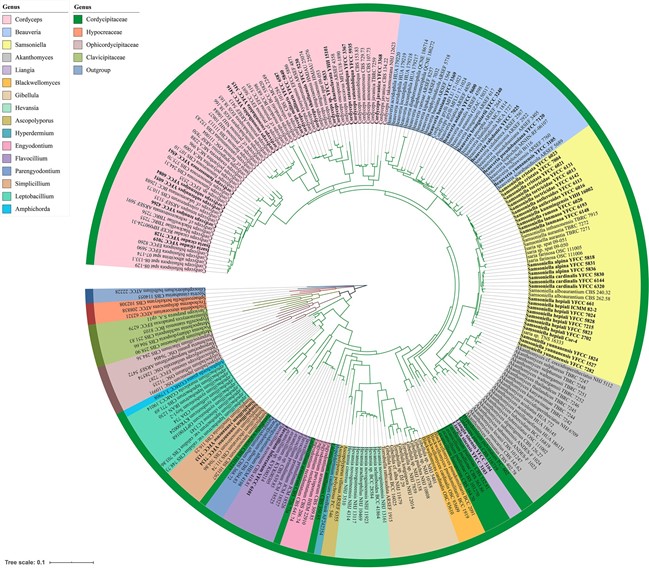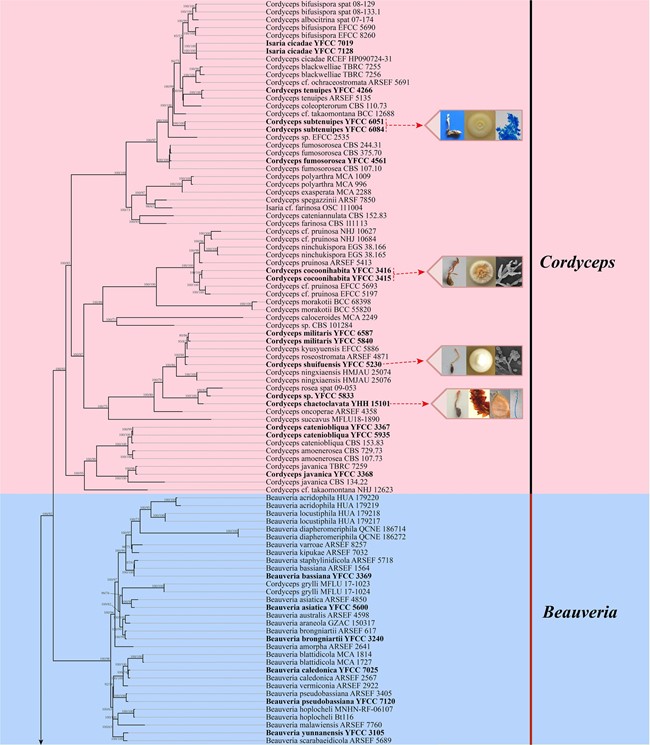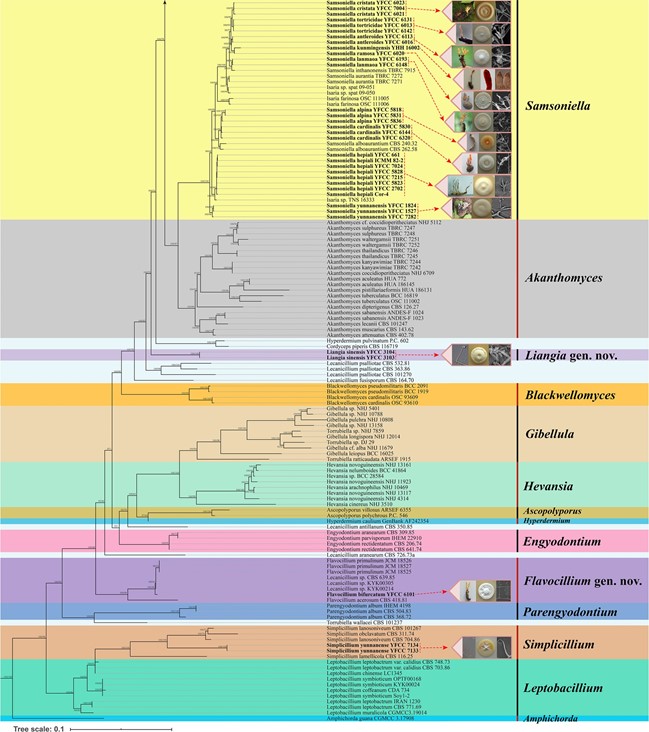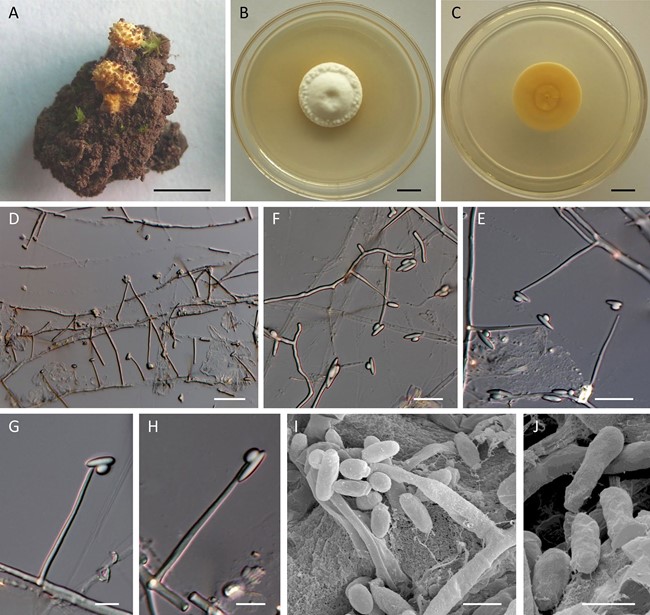Liangia sinensis H. Yu, Y.B. Wang, Y. Wang, Z.H. Chen & Zhu L. Yang, sp. nov.
MycoBank number: MB 833109; Index Fungorum number: IF 833109; Facesoffungi number: FoF14503
Etymology: Named after China where the species is distributed.
Holotype: YHH 7455.
Sexual morph: Undetermined. Asexual morph: Lecanicillium-like. Strains isolated from the stromata of Beauveria yunnanensis associated with the pupa of Lepidoptera. Colonies on PDA slow-growing, 28–34 mm in diameter after 14 days at 25 °C, effuse or stellate, white, usually raising dome-shaped mycelial density with a sunken zone at the centrum, verrucose around the margin. Reverse pale brown, causing a brown concentric ring outside of the inoculum. Hyphae hyaline, septate, branched, smooth-walled, and 0.7–2.4 µm wide. Phialides lanceolate, occurring directly from the prostrate hyphae, solitary, gradually attenuated toward the apex, 16.7–59.0 µm long, 0.7–1.6 µm wide at the base and 0.3–0.7 µm wide at the apex. Conidia existing in two types, macro- and microconidia, aseptate, hyaline, smooth-walled, one-celled, straight, both existing singly or in pairs at the apex of phialides. Macroconidia positioned at a right angle to the apex of phialides, oblong-oval to fusi- form, 4.5–9.3 × 1.2–1.9 µm. Microconidia oval to ellipsoidal, 1.8–3.3 × 1.1–1.8 µm.
Substratum: Beauveria yunnanensis.
Habitat: On the stromata of B. yunnanensis associated with the pupa of Lepidoptera buried in soil.
Distribution: Baoshan City, China.
Material examined: CHINA. YUNNAN PROVINCE: Baoshan City, Mangkuan Village, isolated from B. yunnanensis associated with the pupa of Lepidoptera buried in soil, 22 July 2016, Zi-Hong Chen, (YHH 7455, holotype; YFCC 3103, ex-holotype living culture); Ibid., (YHH 7456; YFCC 3104, living culture).
Notes: Liangia sinensis possesses Lecanicillium-like asexual morph and is characterized by white colonies forming a sunken zone at the centrum of dome-shaped mycelial density and verrucose around the margin, solitary and lanceolate phialides occurring directly from the prostrate hyphae, oblong-oval to fusiform macroconidia, and oval to ellipsoidal microconidia existing singly or in pairs at the apex of phialides.
It is similar to the two phylogenetically more closely related C. piperis and L. psalliotae clades with asexual morph of Lecanicillium (Zare and Gams 2001; Bischoff and White 2004). However, Lia. sinensis differs from C. piperis and L. psalliotae by its distinguished colonies, solitary and lanceolate phialides without conidiophores and oblong-oval to fusiform macroconidia. Cordyceps piperis, originally named T. piperis J.F. Bischoff & J.F. White, was reported to have the sexual morph of Torrubiella with sessile perithecial stromata which covered the corpses of scale insects attached to Piperaceae (Bischoff and White 2004). Lecanicillium psalliotae was originally described as Verticillium psalliotae Treschew which caused diseases of cultivated mushrooms (Treschew 1941), and later were widely discovered from insects, nematodes, soil, mushrooms, Rho- palomyces Corda and other fungi (Dayal and Barron 1970; Zare and Gams 2001; Yang et al. 2005). Liangia sinensis is distinctive for its isolates from the newly described cordycipitoid fungus B. yunnanensis parasitic on the lepidopteran pupa (Chen et al. 2019).
In the five-gene phylogenetic tree, B. yunnanensis (ex- holotype living culture CCTCC AF 2018010 = YFCC 3105) is closely clustered with B. scarabaeidicola (Kobayasi) S.A. Rehner & Kepler, and remotely related to Lia. sinensis (Fig. 1, 2). In this study, there is no strong hyperparasitic evidence that Lia. sinensis grows on the stromata of B. yunnanensis. However, two strains of Lia. sinensis were truly isolated from the stromata of B. yunnanensis. The possibility that Lia. sinensis is a hyperparasitic fungus of B. yunnanensis requires confirmation.

Fig. 1 Phylogenetic tree of Cordycipitaceae and related families inferred from a multigene dataset (nrLSU, nrSSU, tef-1α, rpb1 and rpb2) based on maximum likelihood (ML) and Bayesian inference (BI) analyses. Families of Hypocreales and genera of Cordycipitaceae are differentiated with different colors. Phylogenetic relationships among families of Hypocreales are strongly supported by ML boot- strap proportions and BI posterior probabilities (BP ≥ 70%, PP ≥ 95%)

Fig. 2 Phylogenetic relationships among genera and related species in the family Cordycipitaceae inferred from a multigene dataset (nrLSU, nrSSU, tef-1α, rpb1 and rpb2) based on ML and BI analyses. Values at the nodes before and after the backslash are BI posterior prob- abilities and ML bootstrap proportions, respectively. Support values greater than 50% are indicated at the nodes

Fig. 2 (continued)

Fig. 9 Liangia sinensis. A Stromata of Beauveria yunnanensis arising from the pupa of Lepidoptera buried in soil, from which Lia. sinensis was isolated. B Colony on PDA. C Reverse of colony. D, E Phialides. F–H Macro- and microconidia existing in pairs at the apex of phialides. I Phialides and conidia. J Conidia. Scale bars: A = 5 mm; B, C = 1 cm; D = 20 µm; E, F = 10 µm; G–I = 5 µm; J = 2 µm
